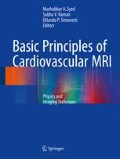Abstract
The constant motion of the heart imposes particular challenges on cardiac magnetic resonance (CMR) as compared to magnetic resonance imaging (MRI) of other organs. Thus, imaging the heart requires synchronization of data acquisition to the cardiac cycle, typically using an electrocardiographic recording of the heart’s electrical activity. This technique is known as electrocardiographic (ECG)-gating. Depending on the specific anatomical or functional information desired, data acquisition may need to occur throughout the cardiac cycle, or may need to be synchronized to a particular phase of the cardiac cycle. This chapter will review basic ECG concepts, ECG-gating modes, common problems and suggestions for troubleshooting these issues.
Access this chapter
Tax calculation will be finalised at checkout
Purchases are for personal use only
References
Cordeiro JM, Greene L, Heilmann C, Antzelevitch D, Antzelevitch C. Transmural heterogeneity of calcium activity and mechanical function in the canine left ventricle. Am J Physiol Heart Circ Physiol. 2004;286:H1471–9.
Sievers B, Addo M, Kirchberg S, et al. Impact of the ECG gating method on ventricular volumes and ejection fractions assessed by cardiovascular magnetic resonance imaging. J Cardiovasc Magn Reson. 2005;7:441–6.
Fischer SE, Wickline SA, Lorenz CH. Novel real-time R-wave detection algorithm based on the vectorcardiogram for accurate gated magnetic resonance acquisitions. Magn Reson Med. 1999;42:361–70.
Paul J, Divkovic E, Wundrak S, et al. High-resolution respiratory self-gated golden angle cardiac MRI: comparison of self-gating methods in combination with k-t SPARSE SENSE. Magn Reson Med. 2014;73(1):292–298.
Liu J, Spincemaille P, Codella NC, Nguyen TD, Prince MR, Wang Y. Respiratory and cardiac self-gated free-breathing cardiac CINE imaging with multiecho 3D hybrid radial SSFP acquisition. Magn Reson Med. 2010;63:1230–7.
Author information
Authors and Affiliations
Corresponding author
Editor information
Editors and Affiliations
Electronic Supplementary Material
Video 9.1
The presence of a TW means that the complete cardiac cycle is not imaged using prospectively gated segmented cine acquisition. As a result, cardiac motion corresponding to the P wave and early QRS complex is not displayed (MP4 77 kb)
Video 9.2
In retrospectively gated segmented-cine acquisition, data is acquired continuously over several R-R intervals enabling interrogation of the entire cardiac cycle (MP4 77 kb)
Video 9.3
Bradycardia is defined as a HR of <60 bpm or an R-R interval >1000 ms. Although not an ECG gating problem per se, it leads to prolonged acquisition/breath hold duration (MP4 77 kb)
Video 9.4
In the setting of irregular rhythms, retrospective gating does not work well since the duration of the cardiac cycle changes for each heartbeat, resulting in a mismatch of the reconstructed phases to the events of the cardiac cycle. The result is a blurry, non-diagnostic image with ghosting artifacts (MP4 77 kb)
Video 9.5
The initial approach to the problem in Video 9.4 is to switch to prospectively gated cine acquisition. The AW duration is then set to be shorter than the shortest RR-interval identified to allow a reasonable TW. If the shortest RR-interval is extremely short, the required AW may be too short to depict end-systole and ejection fraction would be underestimated. The resulting image may not be diagnostic (MP4 77 kb)
Video 9.6
As a single-shot-based technique, real-time images have lower SNR, lower spatial and temporal resolutions (MP4 77 kb)
Rights and permissions
Copyright information
© 2015 Springer International Publishing Switzerland
About this chapter
Cite this chapter
Lopez, D., Salerno, M. (2015). Principles of ECG Gating for CMR. In: Syed, M., Raman, S., Simonetti, O. (eds) Basic Principles of Cardiovascular MRI. Springer, Cham. https://doi.org/10.1007/978-3-319-22141-0_9
Download citation
DOI: https://doi.org/10.1007/978-3-319-22141-0_9
Publisher Name: Springer, Cham
Print ISBN: 978-3-319-22140-3
Online ISBN: 978-3-319-22141-0
eBook Packages: MedicineMedicine (R0)

